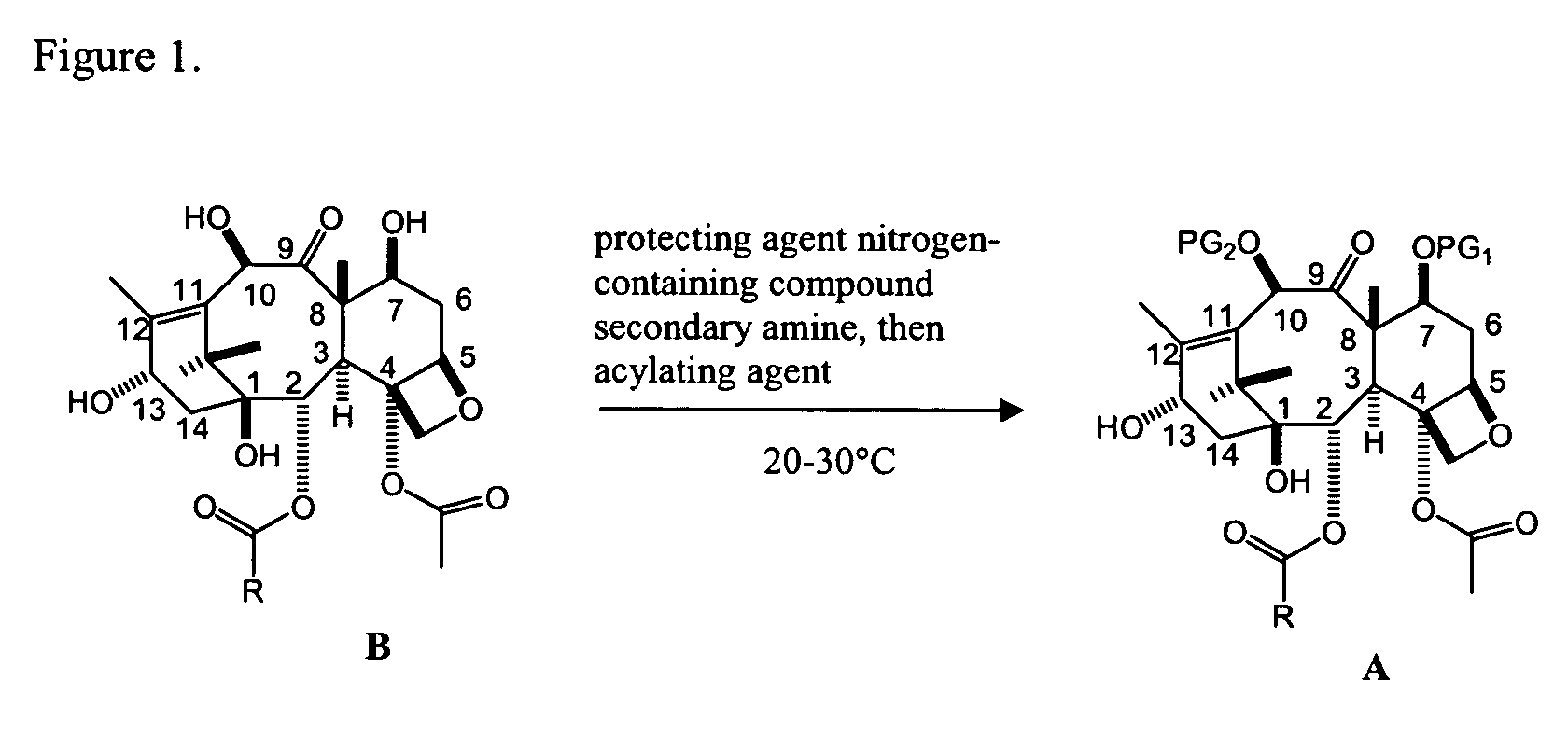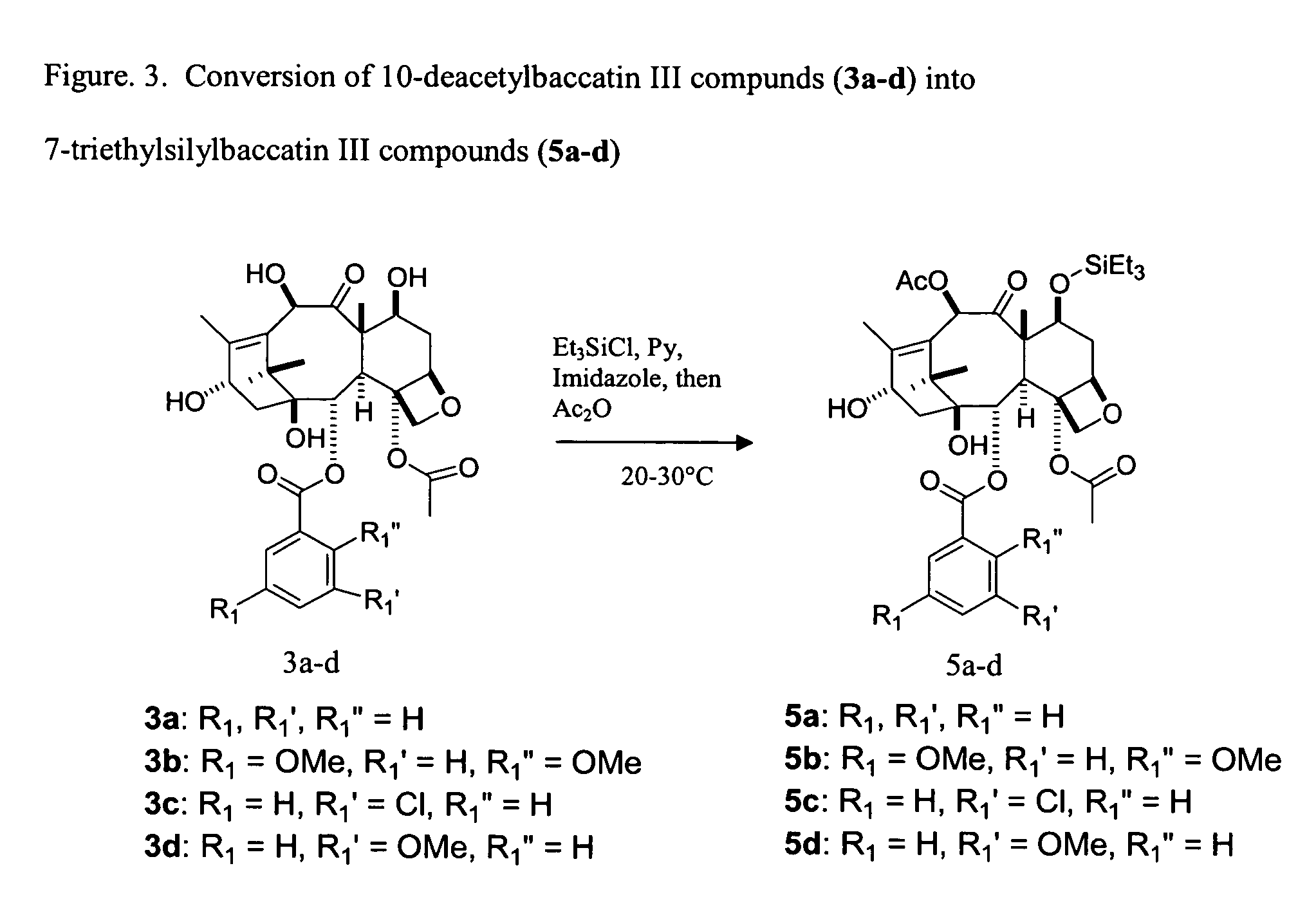Facile method for synthesizing baccatin III compounds
a technology of baccatin and compound, applied in the field of process for synthesis of baccatin iii compounds, can solve the problems of long reaction time, cumbersome process and high cost for scaling up, and the potential of undesired incorporation of triethylsilyl groups
- Summary
- Abstract
- Description
- Claims
- Application Information
AI Technical Summary
Benefits of technology
Problems solved by technology
Method used
Image
Examples
example 1
Synthesis of 7-triethylsilylbaccatin III (5a, FIG. 3)
[0107]10-deacetylbaccatin III (3a) (0.1 g, 0.18 mmol) was dissolved in pyridine (0.5 mL) at about 20 to 25° C. An argon or nitrogen atmosphere was not used. Imidazole (0.074 g, 1.08 mmol) was added to the reaction mixture at about 20 to 25° C., followed by dropwise addition of chlorotriethylsilane (0.06 mL, 0.36 mmol). The reaction mixture was stirred for 5 minutes at about 20 to 25° C., and then treated with acetic anhydride (0.37 mL, 3.9 mmol). The reaction was completed in 4 hours to give the desired product (5a).
example 2
Synthesis of 7-triethylsilyl-2-debenzoyl-2-(2,5-dimethoxybenzoyl)baccatin III (5b, FIG. 3)
[0108]A solution of 2-debenzoyl-2-(2,5-dimethoxybenzoyl)-10-deacetylbaccatin III (3b) (1.50 g, 2.48 mmol) in pyridine (7 mL) was treated with imidazole (0.675 g, 9.93 mmol), followed by chlorotriethylsilane (0.830 mL, 4.97 mmol). The mixture was allowed to stir at about 20 to 25° C., and the progress of the reaction was monitored by TLC (60% ethyl acetate in hexane). After 15 minutes, mono-protection was complete and acetic anhydride (9.2 ml, 97.6 mmol) was introduced into the reaction. The progress of the reaction was then monitored by TLC (30% ethyl acetate in methylene chloride), and found to be complete in 5 hours at about 20 to 25° C. The reaction mixture was diluted with ethyl acetate (40 mL), and washed with water (25 mL), followed by brine (25 mL). The organic layer was dried over anhydrous sodium sulfate, filtered and concentrated in vacuo. The crude product was purified on a silica ge...
example 3
Synthesis of 7-triethylsilyl-2-debenzoyl-2-(3-methoxybenzoyl) baccatin III (5d, FIG. 3)
[0109]To a solution of 2-debenzoyl-2-(3-methoxybenzoyl)-10-deacetylbaccatin III) (3d, 222 mg, 0.39 mmol) in pyridine (1.5 mL) was added imidazole (105 mg, 1.55 mmol) followed by chlorotriethylsilane (0.129 mL, 0.77 mmol). The reaction mixture was allowed to stir at room temperature, and the progress of the reaction was monitored by TLC analysis (60% ethyl acetate in hexane). After 5 minutes, mono-protection was complete, and acetic anhydride (0.728 mL, 7.73 mmol) was introduced to the reaction. The progress of the reaction was then monitored by TLC (30% ethyl acetate in dichloromethane) and found to be complete in 4 h at room temperature. The reaction mixture was diluted with ethyl acetate (10 mL), washed with water (5 mL) then brine (5 mL) and the organic layer was dried over anhydrous sodium sulfate, and concentrated in vacuo. The crude product was purified by silica gel preparatory TLC using 30...
PUM
| Property | Measurement | Unit |
|---|---|---|
| reaction time | aaaaa | aaaaa |
| reaction time | aaaaa | aaaaa |
| temperature | aaaaa | aaaaa |
Abstract
Description
Claims
Application Information
 Login to View More
Login to View More - R&D
- Intellectual Property
- Life Sciences
- Materials
- Tech Scout
- Unparalleled Data Quality
- Higher Quality Content
- 60% Fewer Hallucinations
Browse by: Latest US Patents, China's latest patents, Technical Efficacy Thesaurus, Application Domain, Technology Topic, Popular Technical Reports.
© 2025 PatSnap. All rights reserved.Legal|Privacy policy|Modern Slavery Act Transparency Statement|Sitemap|About US| Contact US: help@patsnap.com



